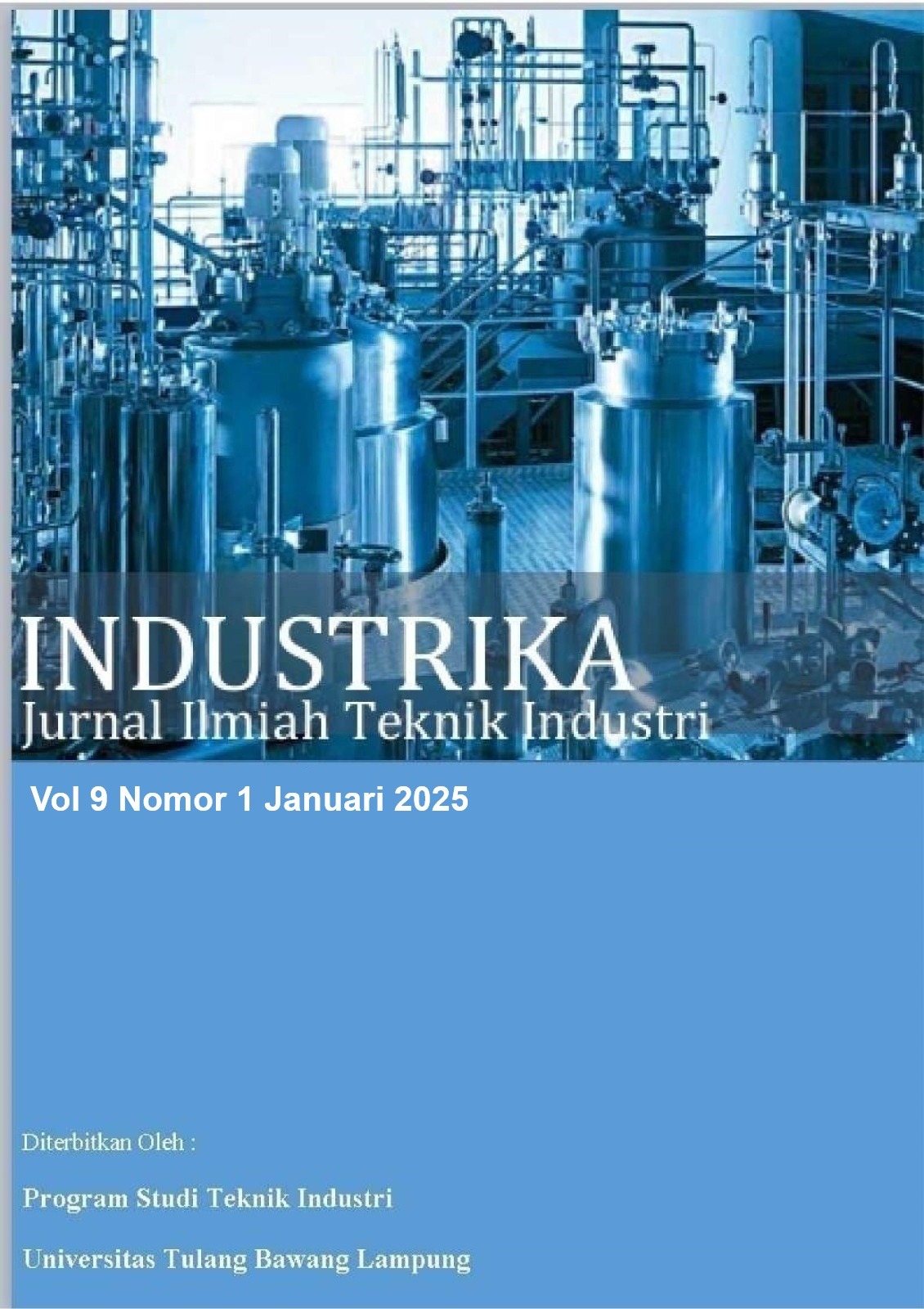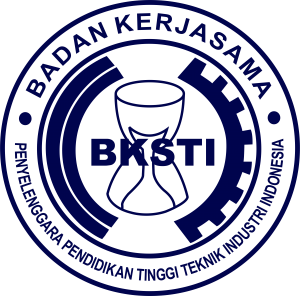Analisis Risiko dan Strategi Peningkatan Keselamatan Kerja di Sektor Industri Manufaktur: Tinjauan Literatur
DOI:
https://doi.org/10.37090/indstrk.v9i1.1901Abstract
Workplace safety in the manufacturing sector is a critical issue, given the high incidence of workplace accidents that may hurt the company and the workers. This study was conducted to analyze occupational safety risks and strategies for improvement, with a focus on the challenges faced in implementing safety policies that are often suboptimal. This research is a literature review employing a descriptive approach, where data from various secondary sources such as academic journals, reports, and official publications are systematically analyzed. The findings of the study indicate four main categories of occupational safety risks in the industrial sector: physical, chemical, ergonomic, and psychosocial risks. The application of technologies, such as automation and monitoring sensors based on the Internet of Things (IoT), has proven effective in reducing workplace accidents, but access to these technologies remains limited. Additional challenges include cost limitations, low worker awareness, weak safety culture implementation, and suboptimal enforcement of safety regulations. This study recommends the importance of collaboration between governments, companies, and workers to strengthen safety culture through investment in technology, ongoing training, and more rigorous regulation enforcement. With these measures, workplace safety in the industrial sector is expected to improve significantly and sustainably. Keywords: industrial risk, occupational safety, regulation, safety strategyDownloads
References
Abdul Rahim, N., Husin, N., Juhari, J., Daud, S. R., Sazimah Ahmad, K., & Mohd Masdek, N. R. N. (2023). Improving Safety Performance by Influence Safety Management Practices and Safety Culture: A Conceptual Framework. International Journal of Academic Research in Business and Social Sciences, 13(10). https://doi.org/10.6007/ijarbss/v13-i10/19064
Amrulloh, M. O. R., Riyanto, E., Rozzaq, & Islamudin, A. (2023). Meningkatkan Kesadaran Keselamatan Dengan Implementasi Lima Pilar Program Melalui Pengukuran Budaya Keselamatan. JIM: Jurnal Ilmiah Mahasiswa Pendidikan Sejarah, 8(3), 2473–2483. https://jim.usk.ac.id/sejarah/article/view/25697/12164
Andi, H. (2020). Program Kesehatan dan Keselamatan Kerja Di Atas Kapal. Jurnal Sains Teknologi Transportasi Maritim, 2(1), 1–10.
Ayodeji Abatan, N., Boma Sonimitiem Jacks, N., Ejike David Ugwuanyi, N., Zamathula Queen Sikhakhane Nwokediegwu, N., Alexander Obaigbena, N., Andrew Ifesinachi Daraojimba, N., & Oluwaseun Augustine Lottu, N. (2024). The Role of Environmental Health and Safety Practices in the Automotive Manufacturing Industry. Engineering Science & Technology Journal, 5(2), 531–542. https://doi.org/10.51594/estj.v5i2.830
B, J. A. Y., Khong, D. W. K., Chin, T. S., & Yusof, A. (2022). Proceedings of the International Conference on Law and Digitalization (ICLD 2022). In Proceedings of the International Conference on Law and Digitalization (ICLD 2022) (Vol. 1). Atlantis Press SARL. https://doi.org/10.2991/978-2-494069-59-6
Balanay, J. A. G., Adesina, A., Kearney, G. D., & Richards, S. L. (2014). Assessment of occupational health and safety hazard exposures among working college students. American Journal of Industrial Medicine, 57(1), 114–124. https://doi.org/10.1002/ajim.22256
Bambang Sudarsono. (2021). Pelatihan Kesehatan Dan Keselamatan Kerja (K3) Sebagai Upaya Pencegahan Resiko Kecelakaan Kerja Bagi Calon Tenaga Kerja Otomotif di Era Pandemi. JURPIKAT (Jurnal Pengabdian Kepada Masyarakat), 2(3), 566–577. https://doi.org/10.37339/jurpikat.v2i3.763
Chaboyer, W., Chamberlain, D., Hewson-Conroy, K., Grealy, B., Elderkin, T., Brittin, M., McCutcheon, C., Longbottom, P., & Thalib, L. (2013). Safety culture in Australian intensive care units: Establishing a baseline for quality improvement. American Journal of Critical Care, 22(2), 93–102. https://doi.org/10.4037/ajcc2013722
Chandra, D., & Djunaidi, Z. (2022). Analisis Pengaruh Dimensi Safety Culture Terhadap Safety Culture Di Industri Petrokimia. PREPOTIF : Jurnal Kesehatan Masyarakat, 6(1), 633–645. https://doi.org/10.31004/prepotif.v6i1.3622
Creswell, J. W. (2017). Research Design: Qualitative, Quantitative, and Mixide Methods Approaches (2nd ed.).
Dimoff, J., & Kelloway, K. (2013). Bridging the Gap: Workplace Mental Health Research in Canada. Canadian Psychology/Psychologie Canadienne, 54, 203. https://doi.org/10.1037/a0034464
Fatach, M. N., Dhartikasari, E., & Rizqi, A. W. (2023). Mengidentifikasi Bahaya dan Pengendalian Resiko Dengan Metode Job Safety Analysis. Jurnal Teknik Industri: Jurnal Hasil Penelitian Dan Karya Ilmiah Dalam Bidang Teknik Industri, 9(1), 44. https://doi.org/10.24014/jti.v9i1.21939
Fatimah, N. S. H., & Wirjatmadi, B. (2023). Pengaruh Paparan Bahan Kimia Terhadap Kesehatan Reproduksi Pada Pekerja. Jurnal Ilmiah Gizi Indonesia, 13(2), 168–175. https://jurnal.stikes-aisyiyah-palembang.ac.id/index.php/Kep/article/view/
Fitriah, R., Murtinugraha, R. E., & Widiasanti, I. (2023). Analisis Kompetensi Ahli Keselamatan Konstruksi Guna Mengurangi Angka Kecelakaan Kerja Konstruksi. Jurnal Serambi Engineering, 8(3), 6521–6534. https://doi.org/10.32672/jse.v8i3.6419
Franita Panggabean, L., Apriliana, G., & Ratna Kinnary, N. (2023). Pengaruh Pelatihan Dan Pengembangan Terhadap Retensi Karyawan Dan Kepuasan Kerja Dengan Keterikatan Karyawan Sebagai Variabel Mediasi (Studi Empiris Pada Generasi Y Dan Z Di Wilayah Jabodetabek). Jurnal Kewidyaiswaraan, 8(2), 45–57. https://doi.org/10.56971/jwi.v8i2.282
Hart, C. (2018). Doing a Literature Review: Releasing the Research Imagination. SAGE Publications. https://books.google.co.id/books?id=ff1BDwAAQBAJ
Haworth, N., & Hughes, S. (2012). The International Labour Organization. In Handbook of Institutional Approaches to International Business. https://doi.org/10.4337/9781849807692.00014
Indrayati, N. K., & Suhariadi, F. (2023). Measuring Training Contribution: Organization Design on a Training Evaluation System based on Return of Training Investment. Psikostudia : Jurnal Psikologi, 12(2), 279. https://doi.org/10.30872/psikostudia.v12i2.10003
Isha, A. S. N., Miza, M. Z., Azeem, S., & Zahid, M. (2019). The Role of Safety-specific Transformational Leadership in Reducing Near Miss Incidents, Using Safety Climate as a Mediator. January. https://doi.org/10.2991/icame-18.2019.21
Khairuddin, M. Z. F., Lu Hui, P., Hasikin, K., Abd Razak, N. A., Lai, K. W., Mohd Saudi, A. S., & Ibrahim, S. S. (2022). Occupational Injury Risk Mitigation: Machine Learning Approach and Feature Optimization for Smart Workplace Surveillance. International Journal of Environmental Research and Public Health, 19(21). https://doi.org/10.3390/ijerph192113962
Khairunnisa, A., & Kamal D.P, N. A. (2023). Deteksi Penggunaan Safety Helmet Menggunakan YOLOv5. Journal of Information Engineering and Educational Technology, 7(2), 74–77. https://doi.org/10.26740/jieet.v7n2.p74-77
Li, Y., Kawasaki, H., Cui, Z., Yamasaki, S., Nakaoka, S., & Shiraishi, M. (2023). Coping With Women’s Menstruation-Related Health Issues in Male-Dominated Companies: A Cross-Sectional Study in Japan. Cureus, 15(11), 1–7. https://doi.org/10.7759/cureus.49569
Mariatie, N., & Hasanah, S. (2021). Pengaruh Pendidikan dan Pelatihan terhadap Etos Kerja serta Implikasinya terhadap Kinerja. EKOMABIS: Jurnal Ekonomi Manajemen Bisnis, 2(02), 191–202. https://doi.org/10.37366/ekomabis.v2i02.220
Misra, S., Roy, C., Sauter, T., Mukherjee, A., & Maiti, J. (2022). Industrial Internet of Things for Safety Management Applications: A Survey. IEEE Access, 10(July), 83415–83439. https://doi.org/10.1109/ACCESS.2022.3194166
Mohd Fuzi, N., Habidin, N. F., Janudin, S. E., & Ong, S. Y. Y. (2019). Critical success factors of environmental management accounting practices: findings from Malaysian manufacturing industry. Measuring Business Excellence, 23(1), 1–14. https://doi.org/10.1108/MBE-03-2018-0015
Mufarikha, M., Misnaniarti, M., Hasyim, H., Novrikasari, N., Windusari, Y., & Fajar, N. A. (2023). Kebijakan Manajemen Dalam Menerapkan Kesehatan Dan Keselamatan Kerja (K3) Di Lingkungan Kerja: Systematic Review. Prepotif Jurnal Kesehatan Masyarakat, 7(3), 16439–16445. https://doi.org/10.31004/prepotif.v7i3.20549
Muhammad, I., & Susilowati, I. H. (2021). Analisa Manajemen Risiko K3 Dalam Industri Manufaktur Di Indonesia: Literature Review. PREPOTIF : Jurnal Kesehatan Masyarakat, 5(1), 335–343. https://doi.org/10.31004/prepotif.v5i1.1635
Nawi, M. N. M., Zainol, N. A. M., Naim, F., Mamat, M. N., Hamzah, N. A., & Nawi, M. N. M. (2023). Employers’ Perceptions of the Manufacturing Industry on Workplace Safety Culture. Journal of Energy and Safety Technology (Jest), 5(2), 78–86. https://doi.org/10.11113/jest.v5n2.123
Nordlöf, H., Wiitavaara, B., Winblad, U., Wijk, K., & Westerling, R. (2015). Safety culture and reasons for risk-taking at a large steel-manufacturing company: Investigating the worker perspective. Safety Science, 73, 126–135. https://doi.org/10.1016/j.ssci.2014.11.020
Pendong, P. E., Moleong, M. M. L., & Pongoh, L. (2024). Manajemen Risiko Bahaya Bahan Kimia Pada Pekerja Tambang Emas Tanpa Izin Di Desa Tokin Kecamatanmotoling. Jurnal Ilmiah Kesehatan Manado, 3(2), 30–35. https://journal.jikma.net
Prasetyawan, P., Samsugi, S., & Prabowo, R. (2021). Internet of Thing Menggunakan Firebase dan Nodemcu untuk Helm Pintar. Jurnal ELTIKOM, 5(1), 32–39. https://doi.org/10.31961/eltikom.v5i1.239
Puspita Dewi, E., Budilaksono, S., Rilla Sovitriana, Nana Trisnawati, Nurina, & St. Trikariastoto, S. T. (2023). Pelatihan Sistem Manajemen Keselamatan, Kesehatan Kerja dan Lingkungan (SMK3L) bagi Pelaku UMKM Kuliner Oleh-oleh Khas Pantai Carita, Banten. JURPIKAT (Jurnal Pengabdian Kepada Masyarakat), 4(2), 111–122. https://doi.org/10.37339/jurpikat.v4i2.1346
Rahayuningsih, S. (2019). Identifikasi Penerapan Dan Pemahaman Kesehatan Dan Keselamatan Kerja Dengan Metode Hazard And Operability Study (Hazop) Pada UMKM Eka Jaya. JATI UNIK : Jurnal Ilmiah Teknik Dan Manajemen Industri, 2(1), 24–32. https://doi.org/10.30737/jatiunik.v2i1.274
Rahmawati, I., Widianto, E., & M. Ishaq, M. I. (2023). Pengelolaan Pembelajaran pada Pelatihan Pengelola Pelatihan Pertanian dan Perdesaan Swadaya. Lifelong Education Journal, 2(2), 155–163. https://doi.org/10.59935/lej.v2i2.135
Ramadhani, T. N., & Hasibuan, A. (2024). Pengaruh Pelatihan Keselamatan dan Kesehatan Kerja Terhadap Pengurangan Tingkat Kecelakaan di Tempat Kerja. Gudang Jurnal Multidisiplin Ilmu, 2(6), 550–555.
Romadon, A. S., Syafitri, L. D., & Ningrum, N. F. (2023). Pengaruh Pendidikan Dan Pelatihan Terhadap Produktivitas Kerja Karyawan Pada Wuryani Konveksi. Jurnal Ilmiah Fokus Ekonomi, Manajemen, Bisnis & Akuntansi (EMBA), 2(01), 11–19. https://doi.org/10.34152/emba.v2i01.648
Sari, E. S., Junarsih, J., & Guchi, R. F. (2022). Penerapan Alat Pelindung Diri Sebagai Upaya Keselamatan Dan Kesehatan Kerja Di Pabrik Tahu Dan Tempe. Literasi: Jurnal Pengabdian Masyarakat Dan Inovasi, 2(2), 1681–1684. https://doi.org/10.58466/literasi.v2i2.691
Sedani, A., Stover, D., Coyle, B., & Wani, R. J. (2019). Assessing workplace health and safety strategies, trends, and barriers through a statewide worksite survey. International Journal of Environmental Research and Public Health, 16(14). https://doi.org/10.3390/ijerph16142475
Selamat, M. N., Akhir, N. M., Aziz, S. F. A., Jaaffar, A. H., & Baker, R. C. (2020). Reliable Dimensions of Ergonomic Work System in the Malaysian Manufacturing Industries. International Journal of Academic Research in Economics and Management Sciences, 9(2). https://doi.org/10.6007/ijarems/v9-i2/7878
Setianingrum, R., Hariyati, R. T. S., & Fitri, D. (2021). Pendidikan Berkelanjutan Melalui E-Learning Bagi Perawat Suatu Program Inovasi. Journal of Telenursing (JOTING), 3(1), 54–62.
Sukapto, P., Djojosubroto, H., & Christian, D. (2019). Implementasi NOSACQ-50, JSA dan Participatory Ergonomics untuk Mewujudkan Lingkungan Kerja yang Nyaman, Selamat, dan Humanum (Studi Kasus). Jurnal Kesehatan, 10(3), 337–345. https://doi.org/10.26630/jk.v10i3.1249
Syawal, S. N., Kusnadi, K., & Sutrisno, S. (2023). Analisis Potensi Bahaya dengan Metode HIRADC untuk Mencegah Terjadinya Kecelakaan Kerja di Departemen Injection PT. Indonesia Thai summit plastech. Jurnal Serambi Engineering, 8(1), 4211–4217. https://doi.org/10.32672/jse.v8i1.5038
Ulfah, A. A., Musriati, T., & Hermawan, D. J. (2023). Analisis Tingkat Pendidikan, Pelatihan Dan Penempatan Kerja Personil Aviation Scurity (Avsec) Di Bandar Udara Abdurahman Saleh Malang. JUMAD : Journal Management, Accounting, & Digital Business, 1(2), 171–180. https://doi.org/10.51747/jumad.v1i2.1353
Wagner, A., Schöne, L., & Rieger, M. A. (2020). Determinants of occupational safety culture in hospitals and other workplaces—results from an integrative literature review. International Journal of Environmental Research and Public Health, 17(18), 1–23. https://doi.org/10.3390/ijerph17186588
Wahyuni, N., Suyadi, B., & Hartanto, W. (2018). Pengaruh Keselamatan Dan Kesehatan Kerja (K3) Terhadap Produktivitas Kerja Karyawan Pada Pt. Kutai Timber Indonesia. JURNAL PENDIDIKAN EKONOMI: Jurnal Ilmiah Ilmu Pendidikan, Ilmu Ekonomi Dan Ilmu Sosial, 12(1), 99. https://doi.org/10.19184/jpe.v12i1.7593
Zhou, M., Chen, X., He, L., & Ouedraogo, F. A. K. (2022). Dual-Attitude Decision-Making Processes of Construction Worker Safety Behaviors: A Simulation-Based Approach. International Journal of Environmental Research and Public Health, 19(21). https://doi.org/10.3390/ijerph192114413
Zondo, R. W. D. (2021). Assessing the effectiveness of an occupational health and safety system in a selected automotive assembly organisation in South Africa. South African Journal of Economic and Management Sciences, 24(1), 1–8. https://doi.org/10.4102/sajems.v24i1.3553
Downloads
Published
Issue
Section
License

This work is licensed under a Creative Commons Attribution-ShareAlike 4.0 International License.









